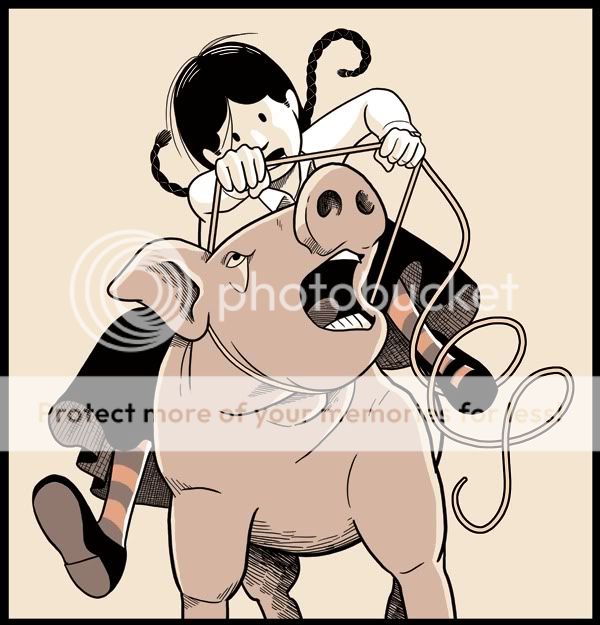Longtime blog readers know a little about my obsessionfascination with hummingbirds. But you don’t have to be a bird enthusiast to fall head-over-heels in love with HUMMINGBIRDS: Fact and Folklore from the Americas (Charlesbridge, 2011). It’s an enchanting tapestry of facts and folklore, woven together with fabric art…a book that invites you to linger, and then return to again and again.
Here’s a handful of inside images, plus pictures of co-authors Jeanette Larson and Adrienne Yorinks:
As a special mid-week treat, I’ve invited Jeanette and Adrienne to a Q-and-A session in The Author’s Tent. The teakettle’s whistling, and we’re surrounded by comfy chairs…please join our conversation!
Oh, and before I forget: Charlesbridge is offering five (count ’em, 5!) copies of HUMMINGBIRDS as contest give-aways! (*Contest particulars below the cut, immediately following the interview.) If you already own this book, you can give your prize to a special friend. But then again, Mother’s Day is right around the corner…
Melodye: Let’s start by pretending, for just a minute, that we’re doing a live interview via Twitter. Jeanette, would you please tweet a 140-character summary of HUMMINGBIRD, followed by a second tweet that describes its audience?
Jeanette (JL): Facts about fascinating creatures found only in the Americas mixed with pourquoi tales from native cultures. Beautiful fabric art adds interest.
For “bird brains” of all ages and anyone who enjoys learning.
Some people think of hummingbirds as spiritual totems; still others admire their physical traits, including but not limited to their ephemoral beauty. Are you drawn to hummingbirds for any special reason(s)?
Jeanette Larson (JL): They are so tiny but so powerful, delicate yet strong and they fascinate me. I don’t know that I see them as spiritual totems, although I know several people who do think, or like to think, that hummingbirds are spiritual representations of a family member or loved one. At programs and signings these stories are some of the more poignant.
Adrienne Yorinks (AY): The first hummingbird I ever saw was in North Salem, New York. I was sitting on my deck after planting beautiful flowers and the hummingbird buzzed my face and sort of rested a minute on my shoulder. I had no idea what it was. I had never heard or seen any of them before and I was enchanted. I thought it was magical. The first thing I thought of was, “this is Tinkerbell.” It was a day that I remember so clearly because it was one of those moments in life where I was feeling a bit sad and reflective and the hummingbird came to me. I felt loved and protected in a way. I have always been drawn to animals. In a spiritual way, they have been my mentors, my loves, my best friends and protectors. A year before my encounter with the hummingbird, I was sitting outside in a different garden, reflecting, and a butterfly landed on my hand and gazed at me. It is a wonderful gift when an animal seeks you out. This has happened a lot in my life and it makes me happy.
Your book is unique in that it stitches together fact and folklore–in seamless fashion, I might add. J When it came time to select your materials, how did you decide what to keep and what to cut?
JL: I can’t talk about selecting fabric or deciding which illustrations to use, if that is what you mean by material J but we did have a lot more information than we could use. The editor handles some of the suggestions for cutting, asking us to omit information that provided details that were extensive or suggesting ways to condense the information. I’ve always felt that it is better to have too much than not enough as it is easier to take embellishments out, revise tighter, and such than it is to try and force in new information and material. In the process, we mix up the words so much that it becomes seamless between what Adrienne wrote and what I wrote. With the help of the editor, Randi Rivers, I hope we cut information that was repetitive and kept interesting and clear information.
AY: Cutting was very tough. I had a unique task because I was both the co-author as well as the illustrator. I know a lot of authors and illustrators can appreciate this quandary. There is a space issue always when doing a picture book. So I had to be a bit cold-hearted to the author part of me when I needed to cut 1,000 words. We had all edited and reedited so many times and then the word came down that 1,000 words had to go. At first I just closed up the document but then my illustrator hat appeared and I cut with gusto! The one part I wish we could have kept in was the factual part about how hummingbirds and flowers have coevolved. The concept of coevolution is so important and interesting to me but it was quite a large segment and I had to weigh the value of it in our book and realized I needed to cut it to make the book work as a whole.
Please describe some of the challenges you faced, from first inspiration to publication day.
JL: One of the biggest challenges was finding a subject we both felt passionate about, that would work well with Adrienne’s art, and that our editor wanted to buy. Then I think we had so many interesting facts that it was difficult to winnow out some to meet the word count. The other challenge, for me, was waiting. It took a long time from when the manuscript was submitted until the art director and book designer decided with Adrienne on the number of illustrations to include and other production factors. It’s hard to be patient!
AY: The one thing that comes to mind is the early loss of our editor Judy O’Malley. I had a wonderful meeting with her about the book. When she became ill, and had to stop working on our book, it was tough to regroup for a bit. Thankfully we had a wonderful team at Charlesbridge with Diane and Randi so that is a happy ending.
What can you tell us about your writing rituals and routines? What sparks your creativity, and what keeps you writing/illustrating when your confidence falters or inspiration doesn’t come?
JL: I don’t know that I have a writing routine. I get very excited by the research and start pulling together a lot of information. I do tend to procrastinate so have to really push myself to set deadlines. I get a lot of inspiration from friends and a very supportive group of writers in the Austin area. Of course I also get inspired by some of the wonderful books I receive every day. There are so many wonderful writers and illustrators! I do tend to write when the muse strikes me.
AY: When I am writing, I work on the computer as well as long-hand because I suppose I am more physical as a person and writing by hand is more satisfying to me. If I am having difficult day writing, I take all of my books and papers to the local library and hide somewhere where there is no interruption. I need a lot of external structure and quiet when I write because it is more difficult to me than illustrating.
When I illustrate, I listen to audio books. I like unabridged books because the longer the better, particularly if they are good. I love mysteries though listen to all sorts of things. My two dogs, Mabou (the border collie) and La Redda (the toy red poodle) are usually in the studio and are wonderful company as I work. I can work on illustrations for hours at a time, and it is not unusual for me to work nine hours in one work session. I also like to work at all times of the day and evening because my medium of fabric appears differently as the light changes and sometimes this inspires subtle changes that add to the depth of the work. Though my most productive starting time is morning after I go to the gym. I always go to the gym first thing in the morning. It helps me to think and concentrate for the rest of the day.
Jeanette, would you mind giving us a tour of your writing space?
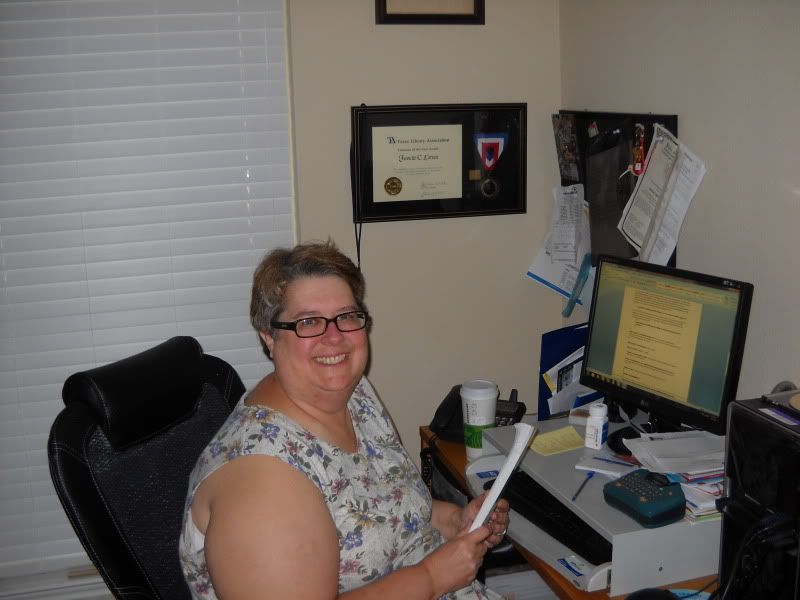
JL: I work from home and have an office that is quite messy. I know that librarians are supposed to be very organized but my books are randomly shelved on very tall bookcases. I also have a book cart, just like in a library, to hold books that I am currently using for projects. One thing I love about my office is that I have two large floor to ceiling windows that look out on birdfeeders, trees, and flowers. The windows let in a lot of light, which is not good for photographs!
And Adrienne, would you be willing to show us around your art studio?
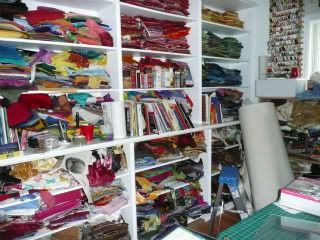
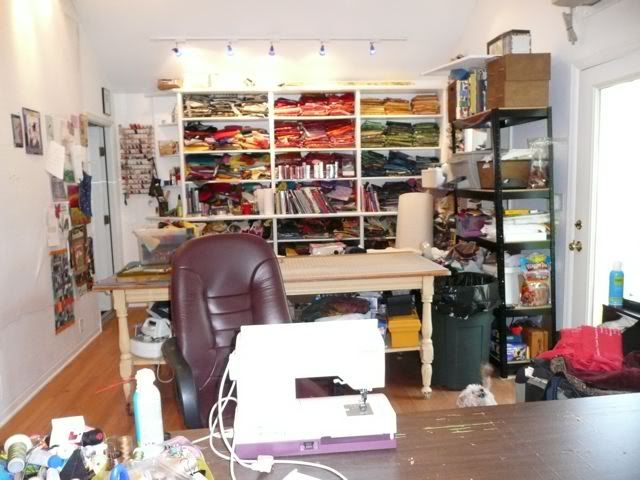
Sorry really messy at the moment…Just finished a large commission (on wall) and am prepping for school visits. This bookshelf [far right] holds all my “conversational prints” that I use for fabric packs for schools. I do a lot of school visits based on my book, Quilt of States, where kids get to do a fabric collage of their state….so I have lots of cow fabric, mountains, tomatoes, etc. on these shelves.
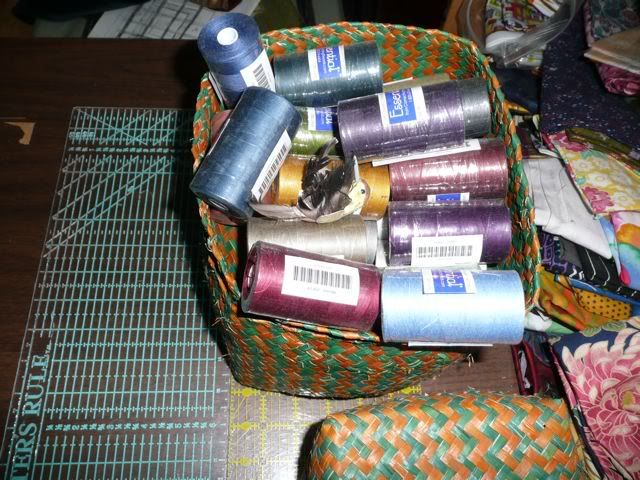
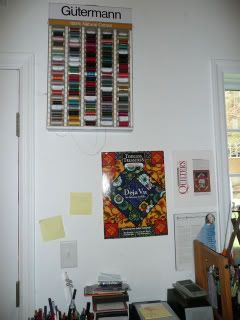
AY: I love thread!
Thanks for your thoughtful, detailed answers! And now, it’s time for our (in)famous LIGHTNING ROUND! A single word will do, but feel free to elaborate whenever you wish.
Wily Coyote or Roadrunner?
JL: Wily Coyote. Roadrunners prey on hummingbirds.
AY: This is so hard because even though I used to root for the Road Runner as a kid, and after all he is a BIRD, Wily Coyote reminds me a bit of Mabou, my beloved border collie and well I love them both…..
American Idol or GLEE?
JL: Glee. I think I do better as part of a team instead of in competition.
AY: I don’t know either of these. I am at a loss for tv….I just watch movies on television and these days, I watch them while I play bridge on my IPAD so I am not really concentrating on movies too much lately except if I go to the movie theatre. I have become obsessed with bridge.
Cannoli or Hummingbird Cake?
JL: Hummingbird cake (definitely hummingbird cake, unless I can have both)
AY: Hummingbird cake.
Violets or Bluebonnets…or a May basket of mixed flowers?
JL: Bluebonnets; I love seeing them each spring and they are a sign that it is wonderful to live in Texas.
AY: Gerber Daisies…….ok Violets but I love Gerber Daisies!
Wings or roots?
JL: Wings. I tend to be restless and want to travel.
AY: Wings! I danced when I was younger and there is nothing as wonderful as feeling like you are flying…just for a second, catching the air. I sometimes look at birds and wonder how it feels to have the freedom of flight.
I’d love to chat with you all day, but since that’s not possible, will you please answer one more question about HUMMINGBIRDS–one that that you haven’t yet been asked in other interviews?
JL: How did you research and write the pourquoi stories? I have always listened to stories and really loved setting myself the challenge to find multiple versions of the same or similar tales so that I could absorb the story and retell it in my own way. I used books, articles, and the Internet to find stories but sometimes had to fill in a few missing pieces from my knowledge of pourquoi stories about other creatures. My skills as a librarian and my undergraduate degree in anthropology came in handy for this part of the book.
AY: So, you mentioned coevolution, can you briefly describe that for us? I am so glad you asked that question! Coevolution is a specialized relationship between two very different species that benefits both species and is reflected in mutual evolution. In this case, we are speaking about flowers and hummingbirds. When hummingbirds drink nectar they are also pollinating the plants they encounter. Hummingbirds have terrific vision but not a great sense of smell so the plants that they have evolved with have lots of nectar, are very colorful with little smell and are tubular in shape to fit their unique bills. Two examples of the plants that have coevolved with hummingbirds are columbine and fuchsia. When the hummingbird hovers over the flower, the hummingbird’s head and back are dusted with pollen and the hummingbird transports the pollen to the next plant and the next plant and so on and so on. The bird and the plant are dependent on each other for survival. So we can thank hummingbirds again, for helping to create such beautiful flowers!
I would also like a brief bio for each of you…anything you want to say about your personal/professional lives, plus your contact information.
JL: I was raised in a military family so we traveled a lot, although not as much as many families did. I credit my parents with instilling in me a sense of adventure and a desire to keep learning about new things. After a childhood spent moving, I’ve pretty much put down roots in Texas although my husband and I moved to a new house 4 years ago. We put in hummingbird and butterfly plants and I have discovered a love of gardening I never knew I had. Once a librarian always a librarian, I say, but after 30 years of working in libraries I took my pension and now write and consult full time. I love the opportunities that publishing Hummingbirds has given me to travel and talk to others who are interested in birding. I continue to learn about these fascinating creatures.
For more about Jeanette Larson, visit www.jeanettelarson.com. You can follow her on Facebook and Twitter, or contact her via email at jeanette@jeanettelarson.com.
AY: My work takes its inspiration from three elements: color, fabric and content. Every facet of my work – large pieces, special memory quilt commissions, and book illustrations – stems from: color – in all its saturation; fabrics – every age, texture, ethnicity and provenance; and content – either the political or emotional impact that drives me.
[I have] written and illustrated several books, including The Last Will and Testament of an Extremely Distinguished Dog, Quilt of States, and The Alphabet Atlas. In my latest book, Hummingbirds: Facts and Folklore from the Americas, I hope to capture the beauty and spirit of the hummingbird through a myriad of fabric based work, from photo transfers to fabric collage using the glittering colors of hummingbirds to captivate my readers.
For more about Adrienne Yorinks, please visit her website: www.adrienneyorinks.com. You can also reach her by email at Adrienne@adrienneyorinks.com.
*CONTEST PARTICULARS: To participate, please leave a comment and/or compliment for the authors on this blog entry. Entries must be submitted by 9:00 p.m. (PDT) on Sunday, May 1st, and winners will be notified via this blog on Monday morning, May 2nd. Want to read more interviews? Please visit the Authors’ Tent archives.




















